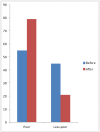The high cost of free tuberculosis services: patient and household costs associated with tuberculosis care in Ebonyi State, Nigeria
- PMID: 24015293
- PMCID: PMC3754914
- DOI: 10.1371/journal.pone.0073134
The high cost of free tuberculosis services: patient and household costs associated with tuberculosis care in Ebonyi State, Nigeria
Abstract
Objective: Poverty is both a cause and consequence of tuberculosis. The objective of this study is to quantify patient/household costs for an episode of tuberculosis (TB), its relationships with household impoverishment, and the strategies used to cope with the costs by TB patients in a resource-limited high TB/HIV setting.
Methods: A cross-sectional study was conducted in three rural hospitals in southeast Nigeria. Consecutive adults with newly diagnosed pulmonary TB were interviewed to determine the costs each incurred in their care-seeking pathway using a standardised questionnaire. We defined direct costs as out-of-pocket payments, and indirect costs as lost income.
Results: Of 452 patients enrolled, majority were male 55% (249), and rural residents 79% (356), with a mean age of 34 (± 11.6) years. Median direct pre-diagnosis/diagnosis cost was $49 per patient. Median direct treatment cost was $36 per patient. Indirect pre-diagnostic and treatment costs were $416, or 79% of total patient costs, $528. The median total cost of TB care per household was $592; corresponding to 37% of median annual household income pre-TB. Most patients reported having to borrow money 212(47%), sell assets 42(9%), or both 144(32%) to cope with the cost of care. Following an episode of TB, household income reduced increasing the proportion of households classified as poor from 54% to 79%. Before TB illness, independent predictors of household poverty were; rural residence (adjusted odds ratio [aOR] 2.8), HIV-positive status (aOR 4.8), and care-seeking at a private facility (aOR 5.1). After TB care, independent determinants of household poverty were; younger age (≤ 35 years; aOR 2.4), male gender (aOR 2.1), and HIV-positive status (aOR 2.5).
Conclusion: Patient and household costs for TB care are potentially catastrophic even where services are provided free-of-charge. There is an urgent need to implement strategies for TB care that are affordable for the poor.
Conflict of interest statement
Figures
References
-
- World Health Organisation (2011) Global Tuberculosis Control: WHO report 2011. Geneva, Switzerland:World Health Organisation. (WHO/HTM/TB/2011.16).
-
- Federal Ministry of Health, Department of Public Health (2010) National tuberculosis and leprosy control programme: workers manual. Revised 5th ed. Abuja, Nigeria: Federal Ministry of Health.
-
- World Health Organisation (2005) Addressing Poverty in TB Control. WHO report 2005. Geneva, Switzerland: World Health Organisation.
-
- Kamolratanakul P, Sawert H, Kongsin S, Lertmaharit S, Sriwongsa J, et al. (1999) Economic impact of tuberculosis at the household level. Int J Tuberc Lung Dis 3: 596–602. - PubMed
-
- Russell S (2004) The economic burden of illness for households in developing countries: a review of studies focusing on malaria, tuberculosis, and human immunodeficiency virus/acquired immunodeficiency syndrome. Am J Trop Med Hyg 71 (Suppl 2): 147–155. - PubMed
Publication types
MeSH terms
LinkOut - more resources
Full Text Sources
Other Literature Sources
Medical
Miscellaneous


